Chapter 7
Model of an Audiovisual Publication in the form of a Web Portal 1
7.1. Introduction
Once the work of segmentation, processing (technical, montage, post-synchronization …) and analysis (description, interpretation, indexing per se…) has been completed, the audiovisual corpus is ready to progress to a new stage in the working process of creating and distributing a piece of cultural or scientific heritage (see Chapter 1) – the publication stage.
As described in the first chapter of this book, publication may be viewed as an automatic process which begins as soon as the analyst deems that his corpus is ready for distribution on the Web. In this case, the analyst sends a command to the technical system which underlies the ASW working environment. The system then takes care of publication the corpus according to a predefined publication model. However, the Publication Workshop in ASW Studio also anticipates the possibility of the analyst becoming an author (or of one person acting as an analyst passing the baton to another person playing the role of an author) to publish the pre-analyzed corpus in accordance with his wishes. In other words, and similarly to the two other workshops of ASW Studio, the Publication Workshop offers the author of a publication a number of options for “personalizing” the publication of an analyzed audiovisual corpus. This personalization, as explained in Chapter 8, includes e.g. choosing between several publication models, the (fairly restricted) possibility of defining a new publication model, selecting the elements to be published from the analyzed corpus, verifying the metadata attached to each selected element and enriching the selected elements, choosing a “style sheet”, etc. In [STO 12a], various models of publication/republication (for new publications of a previously-published corpus) are presented.
In this chapter, we will focus on only one specific model for the publication of pre-analyzed audiovisual corpora – the model of publication in the form of a Web portal. This is the “basic” model of publication, the standard model, in the ASW-HSS project. It is characterized, as we shall see, on the one hand by a series of accesses to an analyzed audiovisual corpus, and on the other by different ways of contextualizing a published audiovisual resource. Remember that, in the context of the ARA program, the standard model of publication takes the form of an event site (the word “event” is used in a rather metaphoric manner for want of a better term, and includes interviews, conferences and cultural manifestations as well as fields per se…). However, as we shall see later on, contextualizing an audiovisual resource (“video”) in relation to an event represents only one of many ways of contextualizing it.
We shall give as detailed a presentation as possible of the typical model for publication in the form of a Web portal. To that end, we will use the example of a particular portal developed as part of the ASW-HSS project – ArkWork – which hosts and distributes an audiovisual corpus dedicated to research in archeology. The various technical aspects of the computerized development of this publication model are addressed in Chapter 10.
Let us reiterate that the publishing of an audiovisual corpus in the form of a Web portal Web is only one specific model. There are many other models, developed and used as part of ESCoM’s ARA program – particularly the “event site” model, which is the standard model of the program, the “thematic folder” model, the “educational folder” model, the “bilingual folder” model, the “video-lexicon” model, etc. (see [STO 12a] for more information).
7.2. The ArkWork homepage
The homepage of the ArkWork portal is accessible from the common homepage shared by all the fields of experimentation (“pilots”) of the ASW-HSS project.1 This page offers entries for each workshop of experimentation. These entries are mutually independent (Figure 7.1). They are represented by the logo of the workshop, which is centered in the middle of the page. Several cover images of the videos have also been presented at the bottom of the page so as to give the users a glimpse of the richness of the workshops’ entire collections. For now, these are the collections of the following workshops of experimentation: Culture Crossroads Archives (CCA), ArkWork, Workshop of Literature From Here and Elsewhere (LHE), Immaterial Cultural Heritage of the Andean People Workshop (PCIA from French) and the Azerbaijani Cultural Heritage (PACA) Workshop. We also use a color-coding system (green for CCA, orange for ArkWork and blue for LHE) to create a visual identity for each workshop and provide users with a reference point during consultation.
Figure 7.1. The common homepage of the three workshops
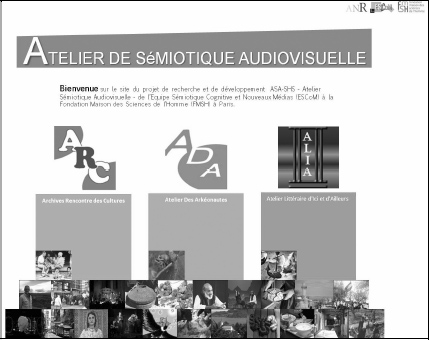
We shall now talk about the homepage which is peculiar to ArkWork (Figure 7.2). This is divided into three main parts organized as follows:
– the top part comprises four tabs (part H1): ASW-HSS, enabling users to return to the common homepage, CCA, ArkWork and LHE. The latter three tabs allow users to change from one workshop to another without going back to the common homepage. At the same level as these tabs, a space is dedicated to the integration of the logos of our project partners. Below (part H2), a horizontal space is provided for two functions: the first (on the left) offers two means of accessing the content: a search engine and a thesaurus belonging to ArkWork. The second (on the right) shows all the social networks that ArkWork is part of, the RSS feed and the functions to print the current page and communicate with other Internet users by messaging services;
– the General information part comprises the sections giving general information relating to ArkWork: presentation, partners, contact and navigation aids. This part also includes a private entry (on the right), reserved for the administrator and the collaborators of the project;
– the central part (C) comprises six main regions set aside for the different functions:
- C1: short texts introducing the portal,
- C2: gallery of randomly-selected videos,
- C3: featured videos,
- C4: different types of direct access (Geo-location, Dating, Participants, Uses, Genres, Visual shots, Sound shots, Languages, etc.),
- C5: thematic access,
- C6: news in the world of archeology.
Figure 7.2. ArkWork homepage
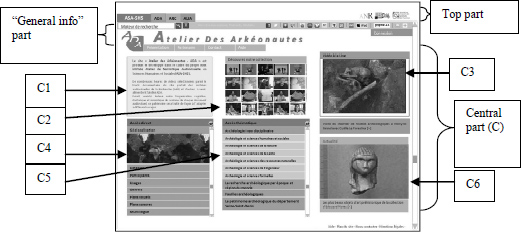
7.3. Thematic access to audiovisual resources
In order to provide users with several types of access to the audiovisual resources of the ArkWork video-library, the prototype offers three main types of access:
– thematic access: this is an access showing themes relating to archeology and hierarchically classified according to the thematic level in the ASW Description Workshop;
– direct accesses:2 these are various types of access conceived according to the different levels in the ASW Description Workshop (e.g. access by geo-location, date, uses, genres, participants, visual shots, sound shots, language, etc.);
– access by thesaurus: access by specific vocabulary in the ASW Description Workshop, classified by approaches and disciplines, historical periods, civilizations and geographical regions.
Thematic access, available from the ArkWork homepage (Figure 7.3), enables users to access resources by the topics they deal with (regarding the analysis of the audiovisual content using the ASW Segmentation Workshop, see Chapter 5).
Figure 7.3. Thematic access to the ArkWork portal
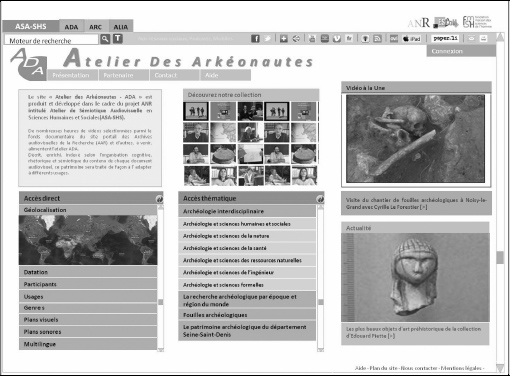
The different headings making up the thematic access to the ArkWork portal refer to the topics pour which there are models of description in the Description Workshop (Figure 7.4). Hence, at the first level, the thematic access to the ArkWork portal offers the following main themes:
– interdisciplinary archeology;
– archeological research by period and by region of the world;
– archeological excavations;
– the archeological heritage of Seine-Saint-Denis.
Some topics in the library of models of description of the ASW Description Workshop are made up of more specialized topics, e.g. in the case of the interdisciplinary archeology.
Figure 7.4. The structure of the thematic level of ArkWork in the ASW description workshop
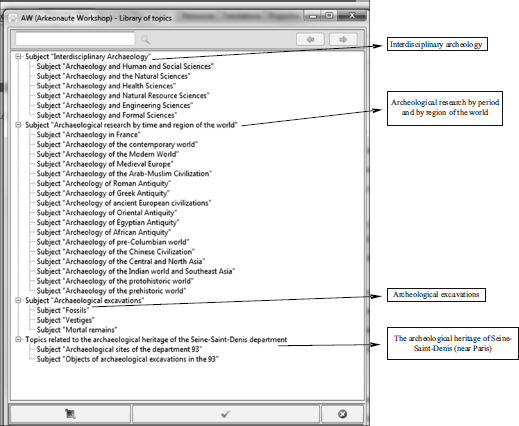
Indeed, the latter comprises the topics “Archeology and human and social sciences”, “Archeology and natural sciences”, “Archeology and health sciences”, “Archeology and natural resources sciences”, “Archeology and engineering sciences” and “Archeology and formal sciences”. These more specialized topics are presented in the second level attached to the first level entitled “Interdisciplinary archeology” in the “Thematic Access” sections of the portal.
For navigating from the homepage of the portal to the audiovisual resources (Figure 7.5), the following scenario may be envisaged. The user chooses a thematic entry from the ArkWork homepage, and is directed to the “Galleries” page, offering various “mini-galleries” of videos corresponding to the chosen topic, classified according to the different “sequences”3 making up the model of description of a topic in the ASW Description Workshop. Then, he chooses a group of videos (represented by a camera icon) in a “mini-gallery”. He then sees a page entitled “Selected videos” offering a series of videos (both segments of videos and whole videos), sorted by different types (genres and target audience).
Figure 7.5. Navigation from the homepage through the “galleries” page to the “selected videos” page

The “Galleries” page represents the sequences of a topic addressed in the ASW Description Workshop (Figure 7.6). For example, the “Archeology and human and social sciences” form of description, which is located in the topic “Interdisciplinary archeology”, in the ASW Description Workshop:
– sequence 1: Presentation of the discipline of archeology;
– sequence 2: Presentation of the disciplines concerned with human and social sciences;
– sequence 3: Presentation of the research topic;
– sequence 4: Presentation of the archeological domain – the research topic;
– sequence 5: Location by country;
– sequence 6: Location in a period of human History;
– sequence 7: Dating by century;
– sequence 8: Personal comments.
The “Galleries” page retrieves the data input into the different sequences of the model of description of a topic (Figure 7.7). These data are “metamorphosed” into cameras and automatically displayed. Consequently, if there are no data in the fields of the forms which are made available in the ASW Workshop of Description, the camera icon is not displayed.
Figure 7.6. The “thematic level” tab in the ASW description workshop representing the form for describing the topic “archeology and human and social sciences” (foreground) and the detailed list of sequence 2.1, comprising the ASW micro-thesaurus “human and social sciences” (background)

Figure 7.7. “Galleries” page, after choosing interdisciplinary archeology and archeology and human and social sciences
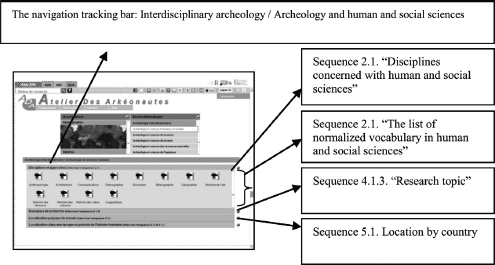
If the user selects, e.g. the camera icon entitled Demography (term listed in the ASW micro-thesaurus “Human and social sciences”), the “selected videos” page (Figure 7.8) is displayed with a series of videos sorted both for a target audience and by their belonging to a genre.
Other spaces on the right of this page include the video display area (Figure 7.8A), the bar with icons for each segment of the video4 (Figure 7.8B), the timeline (Figure 7.8C), the line representing the time-period (Figure 7.8D) and the geographical map (Figure 7.8E). Nevertheless these zones are only active once the user has chosen the video on the left-hand side of the page.
The stage of the navigation from the homepage to the video (Homepage, “Galleries” page, “Selected videos” page) as well as the display of information, will be the same for all entries of the Thematic access.
Figure 7.8. “Selected videos” page

7.4. Direct accesses to the audiovisual resources
Remember that the “direct accesses”5 are the various types of access conceived according to the different levels in the ASW Description Workshop. These are accesses by geo-location, date, uses, genres, participants, visual shots, sound shots and languages.
Similarly as for thematic access, the starting point of “direct access” for navigating from the homepage to the audiovisual resources (Figure 7.9). We shall study three concrete examples of this type of access (by geo-location, date and visual shots) showing the navigation in question.
Figure 7.9. Homepage of the ArkWork portal
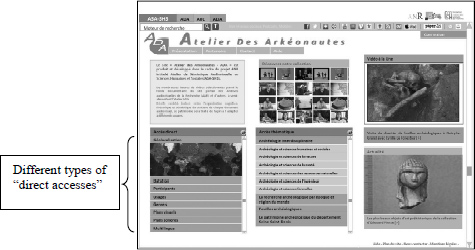
The first form of direct access is by geo-location. This deals with the geo-location of the contents of the audiovisual resources making up the collection of a portal such as ArkWork. The interface of this entry is shown as an interactive menu enabling the user to choose a continent of interest. In our scenario, the user chooses Africa. The “Galleries” page is displayed and offers a series of camera icons presenting different African countries. These are the data that the analyst entered into the field “Location by country”, forming a specific sequence of the model of description of a topic in the ASW Description Workshop. As regards the presentation of these data, a camera icon on this page represents all our resources whose contents are linked with these countries (Figure 7.10).
Navigation on this “Galleries” page is the same as for thematic access. That is to say, when the user clicks on the camera icon, he sees the “selected videos” page which offers a series of videos corresponding to this country, sorted by target audience and by genre of video.
As for access by date, the principle of navigation from the homepage to the audiovisual resources, and the way in which the data are displayed, are the same as with access by geo-location. The data for access by date come from the sequence “Dating and periodization by century” forming a specific sequence of the model for describing a topic in the ASW Description Workshop (Figure 7.11, left). Nevertheless in order to facilitate the user’s search for information, the “Galleries” page for access by date offers two distinct groups of videos: BC and AD (Figure 7.11, right).
Figure 7.10. “Gallery” page for direct access by geo-location

Figure 7.11. Relation between the sequence “dating and periodization by century” of a model for describing the content in the ASW workshop of description and the “galleries” page for direct access by date on the ArkWork portal

The last example of the direct access that we shall look at is access by visual shots. This means of access is very useful, e.g. for lecturers in film studies, in visual anthropology or for other courses and study relating to image analysis. The classification is based on the data which were input during the indexation phase in the “Visual shot” model of description – which is part of the ASW Description Workshop (Figure 7.12).
Figure 7.12. The “visual shot” tab and the list of types of visual objects in the ASW description workshop
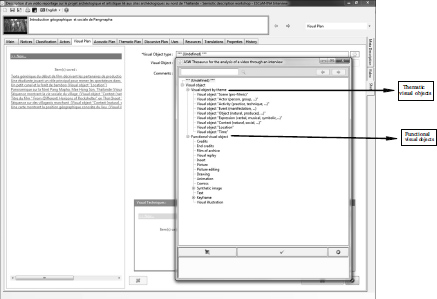
Thus, the presentation of the data on the “Galleries” page for direct access by visual shots is reminiscent of the tree view of the “Type of visual objects” list in the ASW Description Workshop (Figure 7.13). This list comprises two main types (Thematic visual objects and Functional visual objects), which become the headings of the “Galleries” page of visual shots.
Figure 7.13. The “galleries” page for direct access to the visual shots with the data presented in a tree view of the types of visual objects in the ASW description workshop
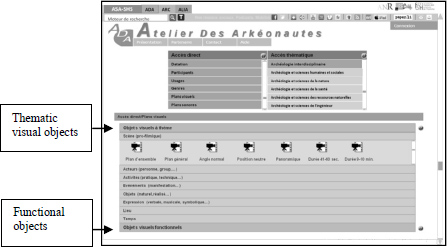
Within the heading “Thematic visual objects”, there are the sub-headings Scene, Actors, Activities, Events, Objects, Expression, Place and Time. In these sub-sections, the information presented as camera icons with titles representing the visual techniques (Establishing shot, Long shot, Normal angle, Neutral position, etc.) is in fact the data which were entered in the “Visual techniques” field attached to each type of visual object in the ASW Description Workshop (Figure 7.14).
Figure 7.14. Model for describing the visual shot in the ASW description workshop showing the data input in the “visual techniques” field to represent a visual object

For example, if the user chooses a visual object of the type “Actor” with the technique “Low-angle shot” (Figure 7.15), he is shown the “Selected videos” page – similarly to with the other means of direct access (Figure 7.16). However, this page only offers a series of segments of video (rather than whole videos) which contain the type of the visual object “Actor” with the technique “Low-angle shot” (Figure 7.16, left).
Figure 7.15. Simulation of the scenario: the user chooses the visual thematic object “actors” with the “low-angle shot” technique on the “galleries” page

Indeed, showing a series of video segments allows the user to find the visual shots that he wants, or the closest to them as possible, at the exact moment in the video.
Figure 7.16. “Selected videos” page for direct access by visual shots
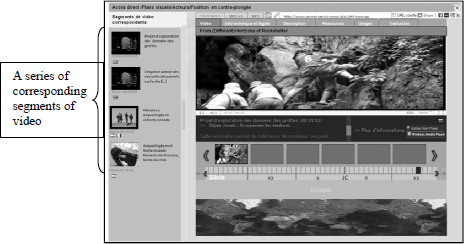
7.5. Access to the audiovisual resources by thesaurus
In fact, the ArkWork portal brings together all the micro-thesauruses of the ASW thesaurus which are relevant to the domain of knowledge/expertise of that portal (Figure 7.17).
Figure 7.17. Relation between the thesaurus page of the ArkWork portal and the structure of the thematic shot in the ASW description workshop
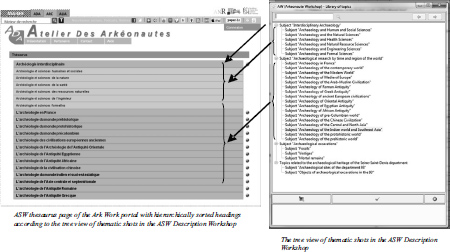
When the user chooses one of the thematic headings to consult, the certified vocabulary banks for each theme appear.
For example, if the user chooses the heading “Archeology and natural resources sciences”, which in itself is a sub-heading of “Interdisciplinary archeology”, he is shown the words related to these themes (Figure 7.17) on the thesaurus page of the of the portal. In this case: Agronomy, Climatology, Forestry and wood sciences, Glaciology, Meteorology, Oceanography, Atmospheric sciences, Speleology and Volcanology. Indeed, these data are the result of the analyst’s work during the phase of indexing of sequence 2.1 of the model for describing the topic “Archeology and natural resources sciences” in the ASW Description Workshop (Figure 7.19). In order to present the wealth of vocabulary in each “micro-thesaurus”, the prototype offers a display system enabling us to present both the set of existing vocabulary and the resources we have available in relation to this vocabulary. If there are indexed videos in relation to a given theme, the word (“term” or “descriptor”) in the thesaurus becomes a URL link to the “Galleries” page offering a series of segments or whole videos, sorted by genre and target audience (Figure 7.18).
Figure 7.18. The display of the vocabulary relating to the themes “archeology and natural resources sciences” on the thesaurus page
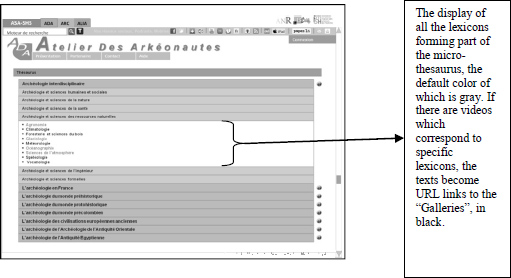
As regards navigation, this path is different from the thematic and direct forms of access. Having chosen a lexicon on the Thesaurus page, the user is directed to the “Selected videos” page, which offers videos and video segments, sorted by genre and target audience, without going through the “Galleries” page (Figure 7.20).
Figure 7.19. Sequence 2.1 of the “archeology and natural resources sciences” description model
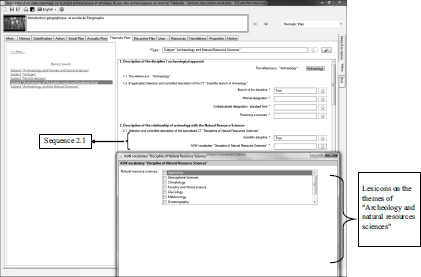
Figure 7.20. Navigation by thesaurus

In summary, for the three types of access (Thematic, Direct and Thesaurus) navigating from the homepage to the audiovisual resources requires the user to change page three times (Figure 7.21). The ergonomics of the “three click” rule is therefore respected.
7.6. Contextualization of the video
This part mainly concerns the information given to contextualize a video on the “Selected videos” page. As stated above, the user has to choose a whole video or a video segment on the left-hand side in order to be able to consult this resource.
Several functions are reserved for the “player” part (Figure 7.22). The first relates to “social networks” and “nomadic” users. It comprises the possibility of downloading the video being consulted in MP4 video format (1) and in MP3 audio format (2). This is very useful for the users of mobile multimedia players such as iPods etc. Then, the prototype also offers the possibility to obtain an embed code (3) for the video. This allows the user to embed this video on his own Website or on other social network platforms.
Figure 7.21. The navigation for the three types of access from the homepage to the audiovisual resources
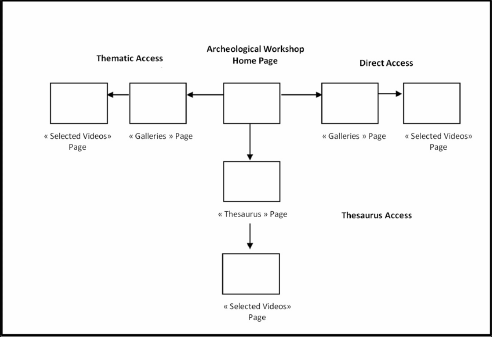
Also, in order to encourage users to promulgate the video they are viewing as much as possible through their social networks, the prototype offers the “short URL” function (4) which shortens the URL of that video. This function is very useful, e.g. for communicating via Twitter.6 Finally, the prototype also offers the “AddThis” service for sharing via more than 50 social networks. All these functions are located above the player.
In terms of information to contextualize each video being consulted, the prototype allows three support systems:
– the textual information;
– the timelines;
– the cartography.
The textual information is the data input via description models in the ASW Description Workshop during the phase of analyzing an audiovisual corpus. A tab system has been put in place to present the data (Figure 7.23). There are six tabs, entitled Video, Technical and legal info, Description, Resources, Uses and Translation.
Figure 7.22. A selected video is displayed in the “player” with different possibilities offered for using it via social networks

The textual information in this tab comprises the title of the video, the duration of the source video and the description of the segment being consulted.
Below the description of the segment, there is a horizontal gallery showing the icons of each segment of the video. If the user hovers on one of these icons with his mouse, the title of the segment is displayed. The prototype offers two systems for displaying these icons. The first is the case for a non-segmented source video (Figure 7.25, left). Only the icon is displayed. The second applies where the source video has been segmented into different sequences (Figure 7.24, right). Several icons are displayed to represent the different segments of this video.
Figure 7.23. System of tabs and other pieces of information to contextualize the video being consulted

The second tab, entitled “Technical and legal info” (Figure 7.25) encompasses the information which was input by the corresponding models of description in the ASW Description Workshop (see Chapter 3): the “General” model (fields: date and place of production)”, the “Citations” model (How to cite, Copyright) and the “Actors” model (First name, Surname, Gender, Profession and e-mail address etc.).
This tab also displays the metadata of the video in accordance with the LOM-FR standard (equivalent IEEE Learning Object Metadata).7
Figure 7.24. Two modes of display of the icons
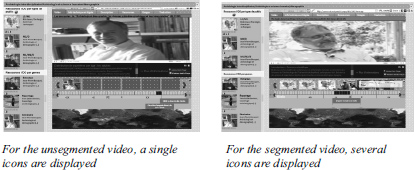
Figure 7.25. The information of the “technical and legal info”, stemming from the different data which were entered in various tabs of the ASW description workshop
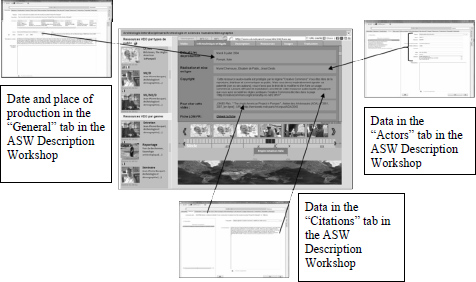
The third tab, entitled “Description” (Figure 7.26A), presents both short and long descriptions of either the whole video or the segment where the video has been segmented. This information is the data entered via the “General” model in the ASW Description Workshop. In addition, there are two other kinds of information which appear on this “Description” tab in our prototype. The first is the audiovisual description, for which the data stem from the information entered via the model for describing the visual shots and sound shots (Figure 7.26B) in the ASW Description Workshop; the second is the thematic description (Figure 7.26C), created using the models for describing the content (Disciplines in archeology, Disciplines concerned with human and social sciences, Research topic, Field of research, Location by country, geographical coordinates, location in period or human history, dating by century) in the ASW Description Workshop.
Figure 7.26. The “Description” tab showing different types of data coming from the forms of description in the ASW description workshop
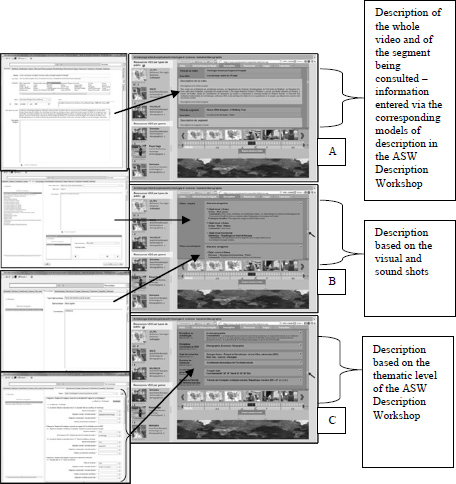
The fourth tab, entitled “Resources”, displays the information entered via the “Resources” model of description in the ASW Description Workshop (Figure 7.27). The organization of the information on the prototype is similar to the tree-type architecture of the information systems in the ASW Description Workshop.
Figure 7.27. The “Resources” tab and the tree view of various typologies of resources in the ASW description workshop (left) and a close-up of the tree view (right)

Indeed, the typology of the resources is divided into two main groups: Resources by domain and Resources by support (Figure 7.28). Hence, the prototype has two levels of information in the form of headings with the system of tabs and accordion effects (Figure 7.29).
Figure 7.28. The “Resources” tab on the prototype with tabs and accordion effects
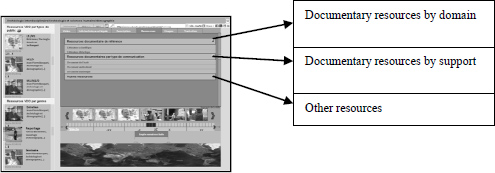
When the user chooses a tab, this tab expands vertically and shows the subheadings containing the information input during the indexing phase. For example, if the user chooses the “Documentary resource by supports” heading, the “Written documents, Audiovisual documents and Digital documents” subheadings open. If he is interested in written documents, he clicks on the sub-heading of that name.
Figure 7.29. The tabs open and offer information which has been hierarchically sorted according to the tree view of the “Resources” tab in the ASW description workshop
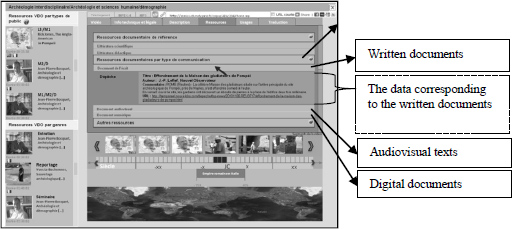
The fifth tab, entitled “Uses”, provides information regarding the use of this video. The information is that which was entered during the indexing phase in the “Uses” model of description in the ASW Description Workshop (Figure 7.30). Three types of information are thus displayed: Context (educational, socio-cultural, patrimonial context etc.), Audience and the analyst’s Comments.
Figure 7.30. The display of the data retrieved in the “resources” tab in the ASW description workshop (left) and presented in the “resources” tab on the prototype (right)

The last tab, for textually contextualizing the video, is called “Translation”. The information in this tab is derived from the models of translation in the ASW Description Workshop (Figure 7.31). This function is very useful to an interested audience who do not understand the original language of the video. The users may choose from the various flags on top of the page.
Figure 7.31. Simulation: displaying the spanish textual translations of the oral discourse
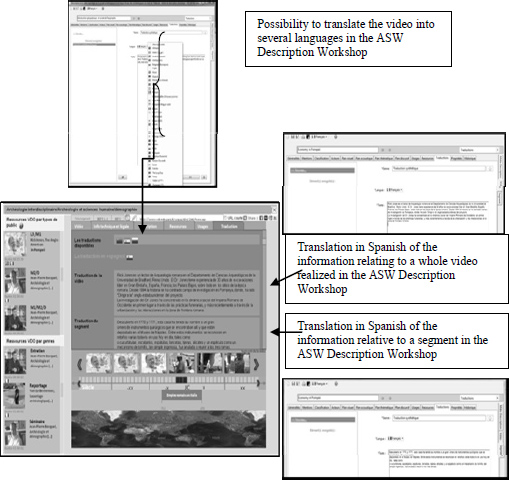
So as best to contextualize the video being consulted, the prototype borrows the concept of a “Timeline” in order to metamorphose the data regarding the dating of the video, input via one of the models of description in the ASW Description Workshop (Figure 7.31). Similarly, just below the dating timeline, another timeline shows the era or period in human history. The data in the form of a horizontal graph represent the information input during the analysis phase in the ASW Description Workshop (Figure 7.32).
Figure 7.32. Graphical and geographical contextualization of the video
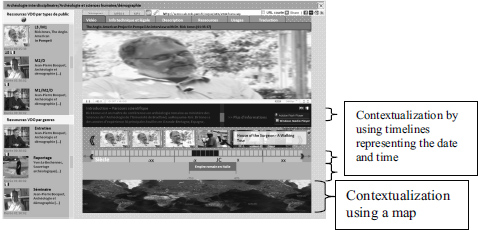
The last form of data for contextualizing the video is the map. The positioning of the fixed point on this map is made possible thanks to the data which were input in the “Location by country of the world” sequence which appears in almost all models of description of audiovisual content forming part of the ASW Description Workshop (Figure 7.32).
The representation of the data in the form of a map or timeline enables the users to quickly gain an idea of the space-time contents of the video being consulted.
1 Chapter written by Jirasri DESLIS.
1 The URL of the portal site for the ASW-HSS fields of experimentation is: http://www.asa-shs.fr/.
2 During the development phase, this theme was changed to “Discover our collections”.
3 The details will be developed in the following section.
4 This is the case where the whole video is segmented into different chapters.
5 The “direct access” theme was used in designing the prototype to present all the possibilities offered to the user for quick and varied access to the resources.
6 Twitter is a micro-blogging service allowing users to blog in short messages (140 characters maximum, one or two sentences). See Chapter 9.
7 LOM is an international standard offering a descriptive model of metadata associated with all educational objects, digital or otherwise. The LOM is not a norm. It is a recommendation of metadata, adopted by the IEEE in 2002. The LOM-FR is the French profile of application of the LOM. Unlike the LOM, this is a norm. The LOM-FR describes educational objects (resources). Any resourced (digital or not) used in a process of learning, formation or training is considered an educational resource. It can be a book, a movie, an educational scenario, a Website, a software package, etc. (see: http://www.educnet.education.fr/dossier/metadata/ressources-educatives-numeriques/lomfr-learning-object-metadata).
